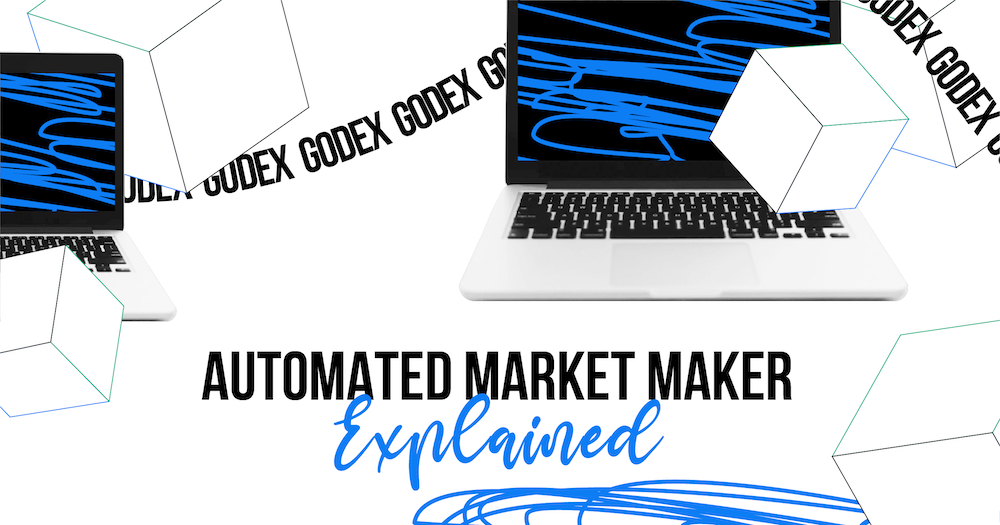Table of Contents
AMM. What Is it?
Let’s start with the definition. AMM is a system that provides liquidity on the exchange where it operates, due to automatic trading. Automatic market makers work much more efficiently than previously used human market makers on exchanges, which manually carried out transactions based on the order book created by people. Automatic liquidity providers have completely solved the problems with the so-called slippage and delays in detecting prices in the market. With the use of AMM prices are regulated without the participation of people.
Introduction of Automated Market Maker
A typical centralized cryptocurrency exchange uses an order book and order matching system to connect buyers with their respective sellers. An order book is a dynamic, real-time electronic record that stores and displays all orders to buy or sell cryptocurrency at different prices at any given time. An order matching system is a specialized software protocol that matches and calculates orders registered in an order book.
Sometimes, if there is a limited number of counterparties with which to trade, the user may not be able to execute their Bitcoin order on the exchange. When this happens, we say that ” the Bitcoin market is illiquid.”
In this respect, liquidity is an indicator or measure of” availability”. I.e., it is the rate at which an asset can be bought or sold without appreciably affecting its price stability.
When the market is illiquid, there are not enough available assets or traders. It becomes difficult to make a trade without having a significant impact on the price of the asset on that particular exchange.
To guarantee liquidity, centralized exchanges employ professional traders represented by banks, brokerages, and a host of other financial groups. They constantly provide a “spread / e / d between buyers and sellers”on the exchange. In other words, these market makers constantly offer to buy and sell an asset at different prices, so that users always have someone to trade with. The process of providing liquidity to an exchange is called market-making, and the organizations that provide this service are called market-makers.
The role of a market maker is to make financial markets more efficient and reduce asset price volatility. Liquidity pools are tokens borrowed for use with the user’s consent, frozen in a smart contract to provide liquidity.
Liquidity pools provide users with the very ability to make transactions directly on the blockchain. Without him, it would have been impossible.
A typical crypto exchange has many pools of liquidity, each of which necessarily contains two different assets linked together in a trading pair. Trading pairs can represent any two tokens, as long as they are part of the ERC20 standard – the most well-known standard for interchangeable tokens. By the way, the largest pool of liquidity on Uniswap is ETH WBTC. It is currently over $ 334 million (March 2021).
The great thing about AMM is that any user can become a market maker. To become one, you need to deposit tokens for an amount equal to the value of two coins in the corresponding pool. For example, 200 LINK and 200 USDT to the USDT link pool. From this, you will receive passive income in the form of a percentage of transactions.
Fees or commissions are determined by each protocol individually and vary depending on the AMM. Before you start, you can study all the conditions. Uniswap, for example, charges a 0.3% commission on each trade, while Curve applies a 0.04% commission.
When the liquidity providers want to stop cooperating, they simply return the tokens to the Smart Contract and get back the amount of coins they provided, plus their commission.
Algorithms of automated market maker
These algorithms are Smart Contracts. Their task is to create a token fund that will provide the price. Since the standard method on ordinary exchanges does not work here. Tokens are automatically traded by the algorithm.
The following main AMMS are currently available in the DeFi system (crypto tools): Uniswap, Balancer, Curve Finance, and Kyber Network.
How is pricing formed on traditional exchanges? Through the application book. There are buyers ‘requests (bid) and sellers’ requests (ask). The last transaction made is the market price. The difference between a bid and an ask is called a spread.
One example of a mathematical formula that AMM uses: X*Y=K.
- X is the number of one token in a currency pair;
- Y is the quantity of the other.
- K is a fixed constant that always remains the same.
This one is used by Uniswap. Different platforms may apply different formulas, but the principle is about the same.
What are the advantages of this approach? AMM allows you to perform operations without the need to search for a counterparty. How does trading on traditional exchanges work? If you want to buy, someone has to sell. Here you interact with the smart contract. The price is always determined by the formula. There is no book of bids, offers, requests, buyers or sellers. There is a pool of liquidity with the volume of different tokens.
Read also Ethereum Smart Contracts – how they work?
Automated Market Maker Variations
Automatic Market Makers is what the crypto system needs, since without it, trading on the exchange is not possible with the token liquidity that most people have. Therefore, the progress and development of technology is accelerated. Today, there are 4 most important and popular types of Automated Market Makers.
- Uniswap has become the most common model. It allows users to create a liquidity pool with any pair of ERC-20 standard coins with a 50/50 ratio.
- Curve is considered the AMM with the lowest bids. It is specifically used for assets such as stablecoins.
- Balancer is another very common variation of AMM. It has broader functionality, allowing users to create dynamic pools of liquidity for up to eight different assets in any ratio.
How do smart contracts automate trading on AMMs?
Instead of using traditional trading methods, decentralized cryptocurrency exchanges rely on Automatic Market Makers or smart contracts. Since the usual tools can’t work here. AMM independently creates pools of token liquidity and sets prices according to mathematical formulas. And they can process this huge amount of information in seconds.
When you make exchanges on decentralized exchanges, you do not interact with other traders. Everything happens within the framework of using a smart contract.
When you make a transaction on an exchange using AMM, a third-party smart contract sends tokens to the liquidity pool to then exchange them for a similar token from the pair. The exchange rate between them is automatically calculated using the mathematical formula, one of which we gave above.
Because of the way AMMS works, there will always be some slippage on every trade. However, as a rule, the more liquidity in the pool, the less slippage of large orders.
FAQ
What is AMM Crypto?
In the world of cryptocurrency exchanges, AMMs are smart contracts. Their functionality is to create pools of token liquidity that are automatically traded using an algorithm.
AMMs determine token prices based on pre-defined mathematical formulas. The capital used to fund these token funds is provided by users on a decentralized exchange. In exchange, they receive a percentage of the commission fees earned by the protocol. With AMM, prices are regulated without anyone’s participation.
Why are AMMs becoming popular?
Automated market makers are the driving force behind decentralized finance. They allow anyone to create markets and trade cryptocurrency seamlessly in a very secure, decentralized and non-custodial manner.
And while AMMS have already experienced massive growth, they are still in their infancy. Inspiring innovations are just around the corner – multi-asset liquidity pools and protocols with non-permanent loss resistance are already being developed and tested.
Once Ethereum 2.0 is fully implemented and DeFi integrates the AMM innovations mentioned above, this new type of funding will become unstoppable and quite possibly widespread.
What are the risks and limitations of AMMs?
Non-permanent loss is the main and most common risk faced by liquidity providers in AMM. In essence, this is the reduction in the value of the token that users experience when depositing tokens in AMM, compared to if they held them in the wallet for the same time. The market maker prices each bet so that he is indifferent between a trader declining and accepting it.
A non-permanent loss occurs when the market price between the tokens deposited in the AMM diverges in either direction. As a rule, the greater the difference between the prices of tokens after they are deposited, the more significant the non-permanent losses are.
Start a Cryptocurrency exchange
Try our crypto exchange platform
Disclaimer: Please keep in mind that the content of this article is not financial or investing advice. The information provided is the author’s opinion only and should not be considered as direct recommendations for trading or investment. Any article reader or website visitor should consider multiple viewpoints and become familiar with all local regulations before cryptocurrency investment. We do not make any warranties about reliability and accuracy of this information.
 Alex Tamm
Alex Tamm 
Read more
Ripple (XRP) price has been widely discussed by the cryptocurrency community since it has gained public interest in 2017, even though it was founded by Chris Larsen and Jed McCaleb years before. The platform offers innovative blockchain solutions for the banking sector and has the potential to disrupt the whole finance industry. In recent years, […]
In this article we will talk about Ripple (XRP) and its price prediction. What is Ripple (XRP) Ripple is a San Francisco-based startup that was launched in 2012 by Ripple Labs as a global network both for cross-currency and gross payments. Ripple history began in 2004 with the discussions around the digital coin in the […]
You may well think that an article dedicated to a Tether price prediction or the Tether price in general is a little bit strange — it is a stablecoin after all. However, the price of Tether does fluctuate significantly, although it is nowhere near as volatile as non-stablecoin cryptos. This means that staying up to […]
In the article we share our vision at Zcash cryptocurrency main features and add several price predictions. As cryptocurrencies gain global acceptance and decentralisation slowly enters our lives, privacy becomes the main concern when talking about blockchain adoption. It is no secret that distributed ledger is by far the most secure and transparent technology ever […]
Chiliz coin (CHZ) offers a compelling opportunity for traders interested in the intersection of blockchain technology and sports. By enabling fans to influence team decisions through the Socios app, Chiliz directly monetizes fan engagement and connects with major sports teams like Juventus and Paris Saint-Germain. These partnerships not only enhance the platform’s visibility but also […]
The exponential growth of Bitcoin Satoshi Vision (BSV) against the general bear trend on the cryptocurrency market in autumn 2019 has impressed the community. Due to the increasing market capitalization, the newly emerged altcoin was ranked 5th on CoinMarketCap and managed to maintain its high position at the beginning of 2020. In the article we […]